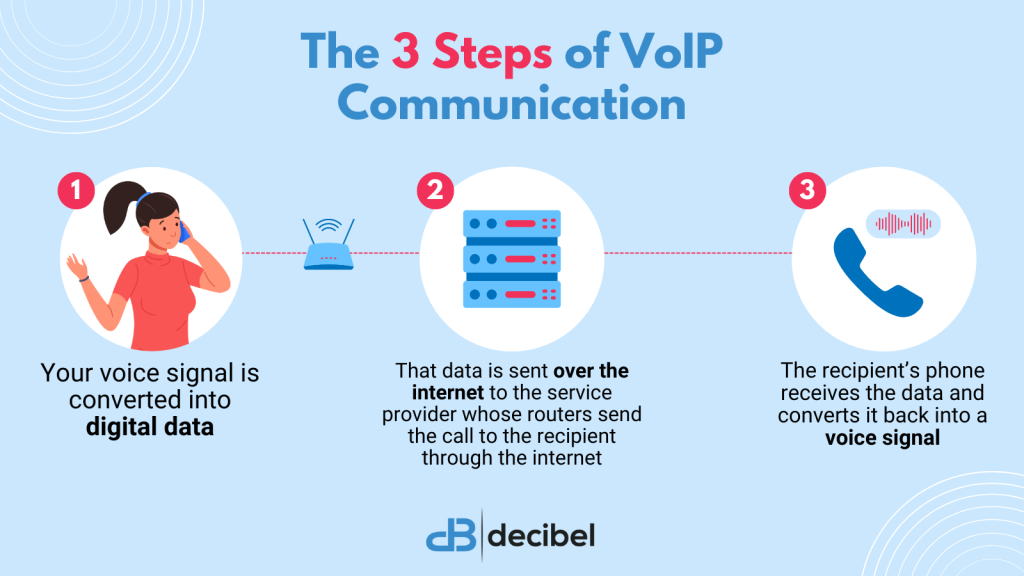This guide is for all the professionals who have been haunted by the question: “What is a cloud-based phone system?” The people who’ve wondered how it works or why it’s become the go-to solution for so many businesses.
Today, you’ll receive your answers.
What is a Cloud-Based Phone System?
A cloud-based phone system is a telephone service that operates over the internet instead of traditional phone lines. It does this using a technology called Voice over Internet Protocol (VoIP).
These systems are hosted in the cloud (i.e., on a dedicated server) by a service provider who manages all the necessary hardware and software off-site. They also take care of all the system’s maintenance and upgrades! All you need is the right kind of office phone.
Some of you might know these systems by a different name. That’s typical! Many in the industry choose to use different names for cloud-based systems, names that focus on one facet of what cloud-based phones can do, like:
- VoIP System: Emphasizes the use of internet protocol for voice communication.
- Hosted PBX: Focuses on the system being hosted and managed by a third-party provider.
- Virtual Phone System: Stresses the non-physical, flexible nature of the service.
According to Gartner, 85 percent of companies will embrace cloud-first policies by 2025 – and that includes cloud-based phone systems.]
How Do Cloud-Based Phone Systems Work?
Now that we’ve answered, “What is a cloud-based phone system,” it’s time to talk about how it works. Let’s break it down into three major steps:
Step 1: Voice is Converted to Data
When you speak into a cloud-based phone, your voice (an analog signal) must be converted into digital data. This conversion happens using an Analog-to-Digital Converter (ADC) within your desk phone or mobile device.
Step 2: Data is Transmitted
Once your voice is converted into digital data, this data needs to be sent over the internet to the person you’re calling. Here’s how the process works:
First, packetization. The digital voice data is broken down into small packets, like tiny envelopes containing parts of your conversation.
Second, labeling. These packets are then labeled with the source IP address (the phone you’re calling from) and the destination IP address (the phone number you’re calling).
Third, sending and routing. Once the packets are labeled, they’re sent to the internet, where routers determine the best path for each to travel.
Because the internet is so vast and interconnected, routers must use algorithms to find the most efficient route for the data packets based on network traffic, path availability, and route efficiency.
Think of them as postal sorting centers directing the packets to the right destination based on their IP addresses.
Fourth, transmission. The packets move from router to router across different networks (also known as hops). Each is a checkpoint that helps guide the packets closer to their destination – the network of the person you’re calling.
Fifth, arrival. When the data packets reach the recipient’s network, they pass through that network’s gateway. This device directs them to the phone or device that matches the final portion of the recipient’s IP address.
Step 3: Data is Received
The packets reach the recipient’s phone and are reassembled in the correct order to form a clear digital voice signal. The recipient’s phone converts that signal back into an analog one, allowing them to hear what you’re saying.
This entire process – from conversion to reception – happens in milliseconds so that you can converse in real-time.

Advantages of a Cloud-Based Phone System
Hundreds of companies have switched to cloud-based phone systems over the last few years. Why? Because they provide all kinds of advantages that conventional phone systems typically don’t. Here are just a few examples:
- Cost Savings: Traditional phone systems require substantial investments in hardware, maintenance, and upgrades, not to mention long-distance charges and other fees. But with a cloud-based phone system, your provider handles maintenance and updates for one low monthly fee. Because it uses your existing internet connection, you eliminate many costly copper fees, reducing your communication bills by up to 75 percent!
- Scalability: With a cloud-based phone system, you can easily add or remove lines and features as your needs change without the need for additional hardware or complex configurations.
- Work Flexibility: Cloud-based phone systems like ours are equipped with comprehensive softphone apps that let employees work from anywhere using any device, making hybrid work a cinch.
- Advanced Features: Using a cloud-based phone system means you have access to all the capabilities you need to succeed. These include instant call routing through auto attendants, detailed analytics for performance monitoring, plug-and-play integrations, and so much more!
- Reliable Disaster Recovery: Our system comes with built-in redundancy and disaster recovery options. If an outage occurs, calls can be automatically rerouted to other locations or devices, so your communications stay online even if you don’t.
And there you have it – the fundamentals of cloud-based phone systems and their benefits for your business.
Stay tuned for more in-depth discussions about specific features, use cases, and implementation tips for cloud-based phone systems on our blog!
What is a Cloud-Based Phone System from Decibel? A Good Investment.
Our solution not only offers all the advantages we discussed in this guide, but also boasts highly personalized service, reliable support, and competitive pricing. Don’t settle for mediocre – reach out to Decibel to enjoy better communication today!

